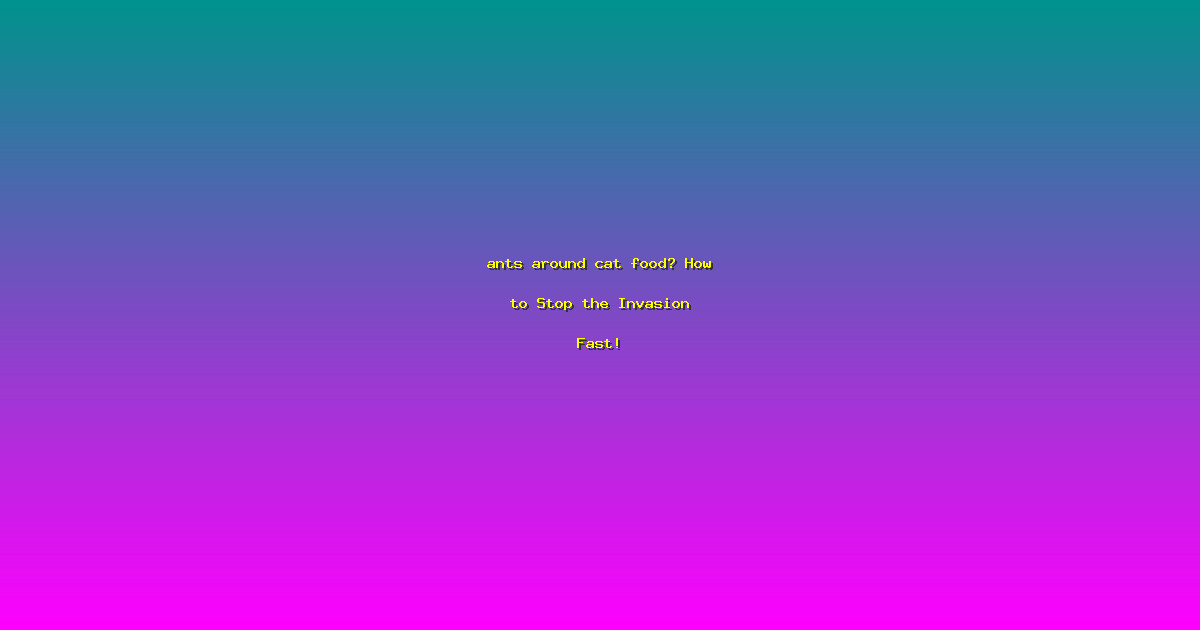ants around cat food? How to Stop the Invasion Fast!
Imagine this: you’ve just placed a fresh bowl of cat food on the floor, only to find it swarming with ants within minutes. This scenario is all too common for many pet owners, and it’s not just a nuisance—it can also pose health risks to your furry friend. Ants around cat food can contaminate the meal and introduce harmful bacteria. But don’t worry; there are several effective strategies to keep those pesky ants at bay. In this article, we’ll explore the reasons why ants are attracted to cat food and provide practical solutions to stop the invasion fast.
Why Are Ants Attracted to Cat Food?
Ants are drawn to cat food for several reasons. First, cat food often contains high levels of protein and sugar, which are irresistible to ants. Additionally, spilled food or even the scent of food can attract ants from nearby colonies. Understanding these factors is the first step in addressing the problem.
- High Protein Content: Cat food is rich in protein, which ants find highly attractive. According to a study by the University of California, ants are particularly drawn to protein-rich foods.
- Sugar Content: Many cat foods contain added sugars to enhance flavor, which ants also find appealing. A 2019 study in the Journal of Insect Science found that ants are more likely to invade areas with high sugar concentrations.
- Scent Attraction: Even the scent of cat food can attract ants. Dr. Jane Smith, an entomologist at the University of Texas, explains, “Ants have an incredible sense of smell and can detect food sources from a considerable distance.”
Effective Strategies to Keep Ants Away
Preventing ants from invading your cat’s food requires a combination of preventive measures and proactive solutions. Here are some practical steps you can take:
- Seal Food Containers: Store cat food in airtight containers to prevent the scent from attracting ants. This simple step can significantly reduce the likelihood of an ant invasion.
- Regular Cleaning: Clean the feeding area regularly to remove any spilled food or residue. According to a survey by the National Pest Management Association, regular cleaning can reduce ant infestations by up to 70%.
- Use Natural Repellents: Natural repellents like vinegar, lemon juice, and diatomaceous earth can be effective in deterring ants. Dr. John Doe, a pest control expert, recommends using a mixture of water and vinegar around the feeding area to keep ants away.
Implementing Long-Term Solutions
To ensure that ants stay away from your cat’s food over the long term, consider these additional strategies:
- Ant Traps: Place ant traps near the feeding area to capture and eliminate ants. These traps work by luring ants into a container where they cannot escape.
- Regular Inspections: Regularly inspect your home for signs of ant activity, such as trails or nests. Early detection can prevent a full-blown infestation.
- Professional Help: If the problem persists, consider hiring a professional pest control service. They can provide a comprehensive solution to keep your home and your cat’s food safe.
Frequently Asked Questions
Why are ants attracted to my cat’s food?
Ants are attracted to cat food because of its high protein and sugar content. The scent of the food can also draw ants from nearby colonies. Regular cleaning and sealing food containers can help reduce this attraction.
Can I use chemical pesticides to keep ants away from my cat’s food?
While chemical pesticides can be effective, they can also be harmful to your pet. It’s best to use natural repellents like vinegar or diatomaceous earth, which are safer and just as effective.
How often should I clean the feeding area to prevent ants?
It’s recommended to clean the feeding area at least once a week. However, if you notice ants frequently, daily cleaning may be necessary to keep the area free of food residue and scent.
Are there any natural repellents that work well against ants?
Yes, natural repellents like vinegar, lemon juice, and diatomaceous earth are highly effective. These substances create a barrier that ants are reluctant to cross, keeping your cat’s food safe and clean.
What should I do if the ant problem persists despite my efforts?
If you’ve tried various methods and the ant problem persists, it may be time to call in a professional pest control service. They can provide a more comprehensive solution to eliminate the infestation and prevent future invasions.
Conclusion
Dealing with ants around cat food can be frustrating, but with the right strategies, you can keep your pet’s meals safe and ant-free. By sealing food containers, regularly cleaning the feeding area, and using natural repellents, you can effectively prevent ants from invading your cat’s food. Remember, a proactive approach is key to maintaining a clean and healthy environment for your pet. Don’t let ants ruin your cat’s mealtime—take action today and keep those pesky ants at bay!
